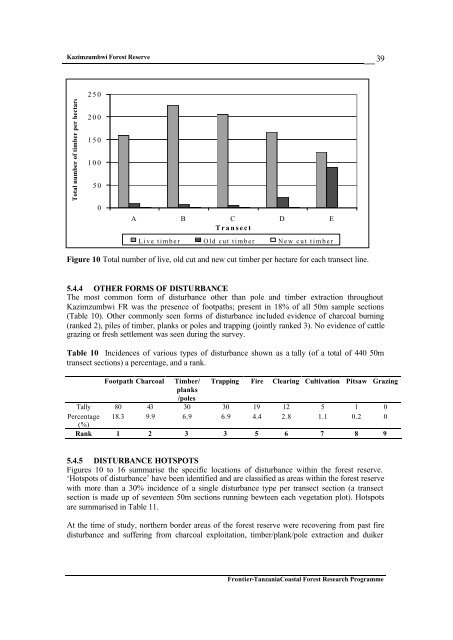Frontier Tanzania Environmental Research REPORT 110 ...
Frontier Tanzania Environmental Research REPORT 110 ...
Frontier Tanzania Environmental Research REPORT 110 ...
You also want an ePaper? Increase the reach of your titles
YUMPU automatically turns print PDFs into web optimized ePapers that Google loves.
Kazimzumbwi Forest Reserve<br />
39<br />
Total number of timber per hectare<br />
250<br />
200<br />
150<br />
100<br />
50<br />
0<br />
A B C D E<br />
Transect<br />
Live timber Old cut timber New cut timber<br />
Figure 10 Total number of live, old cut and new cut timber per hectare for each transect line.<br />
5.4.4 OTHER FORMS OF DISTURBANCE<br />
The most common form of disturbance other than pole and timber extraction throughout<br />
Kazimzumbwi FR was the presence of footpaths; present in 18% of all 50m sample sections<br />
(Table 10). Other commonly seen forms of disturbance included evidence of charcoal burning<br />
(ranked 2), piles of timber, planks or poles and trapping (jointly ranked 3). No evidence of cattle<br />
grazing or fresh settlement was seen during the survey.<br />
Table 10 Incidences of various types of disturbance shown as a tally (of a total of 440 50m<br />
transect sections) a percentage, and a rank.<br />
Footpath Charcoal Timber/ Trapping Fire Clearing Cultivation Pitsaw Grazing<br />
planks<br />
/poles<br />
Tally 80 43 30 30 19 12 5 1 0<br />
Percentage 18.3 9.9 6.9 6.9 4.4 2.8 1.1 0.2 0<br />
(%)<br />
Rank 1 2 3 3 5 6 7 8 9<br />
5.4.5 DISTURBANCE HOTSPOTS<br />
Figures 10 to 16 summarise the specific locations of disturbance within the forest reserve.<br />
‘Hotspots of disturbance’ have been identified and are classified as areas within the forest reserve<br />
with more than a 30% incidence of a single disturbance type per transect section (a transect<br />
section is made up of seventeen 50m sections running bewteen each vegetation plot). Hotspots<br />
are summarised in Table 11.<br />
At the time of study, northern border areas of the forest reserve were recovering from past fire<br />
disturbance and suffering from charcoal exploitation, timber/plank/pole extraction and duiker<br />
<strong>Frontier</strong>-<strong>Tanzania</strong>Coastal Forest <strong>Research</strong> Programme

















